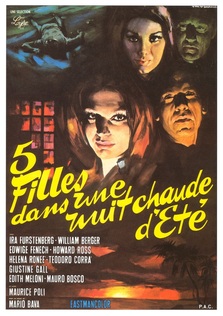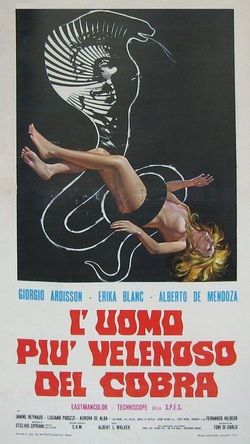
A trio of millionaires invite a professor/inventor to an island retreat, hoping to persuade him to sell a secret formula for industrial resin. They are each accompanied by their wives, some of whom are harbouring secrets (lezzin' rather than resin) of their own. A (mostly) unseen assailant begins knocking off the wholly-unfleshed-out characters one by one. Who is behind the murders, and why is there a teenage girl running around the island entirely unsupervised?
5 Dolls for an August Moon marked a return to the giallo genre for Mario Bava, six years after his genre-defining Blood and Black Lace. (It is worth noting that the film was released in Italy one week before the genre re-defining Bird With the Crystal Plumage.) Essentially a reworking of Agatha Christie's Ten Little *cough* Indians, the film was shot in 19 days, and has been denounced by no less than the director himself as being his worst film.
As anyone who's seen Dr Goldfoot and the Girl Bombs would testify, Bava didn't always get it right. And, as anyone who's seen Dr Goldfoot and the Girl Bombs would testify, 5 Dolls is not his worst film. It's obvious that Bava had little interest in the script or characters of the film (the latter being a pity, as the cast is top-notch), but he made up for this by directing the absolute s**t out of it. If one was to approach the film expecting something along the lines of B&BL (or Bava's other famous giallo, Bay of Blood), it'd be impossible to be anything but let down by it, as you'd be hard-pressed to argue that 5 Dolls is anything other than a failure as an out-an-out giallo. The murders either occur off-screen, or involve death-by-gunshot (which most genre enthusiasts would probably agree is even less agreeable than an off-screen murder); there are no real stalk-and-slash sequences, and there is no concrete line of investigation taken by any of the characters, who spend most of their time hanging out, trying to steal scientific formulae, and shagging. Oh, and occasionally hanging a corpse in the walk-in freezer.
Bava had just come off a brace of spy pictures (the aforementioned Dr Goldfoot and Danger: Diabolik), and the pop-art aesthetic of these films is alive and well here, with the decor of the villa in which much of the action is set being straight out of a 60s spy caper. The McGuffin at the centre of the plot, a formula in the possession of William Berger's scientist, as well as the logic underpinning the film's final revelation, also sit uneasily within the confines of the giallo.
While I disagree strongly with Bava's assertion that it's his worst film, it is plain that he is coasting* along. However, as I said above, his direction is at times phenomenal. The entire film takes place in either set-based interiors or at the seaside, the two locations where Bava was most comfortable throughout his career. The film's rushed production schedule likely forced him to think creatively, and he utilizes the restless-camera-on-a-tripod approach here to greater effect than in Bay of Blood, where the zooms and reframings can occasionally become intrusive. They do intrude here, but only when Bava wants them to. The final shot of the sailor sequence is an example of a seemingly simple shot which is perfectly conceived and executed. Also worth a special mention is the wrestling sequence, which turns into a marbles-falling-down-stairs sequence, which directly leads to the discovery of an apparent suicide. If this sounds a bit scattershot and mad, it is. And so is the film.
|
|
Ultimately, 5 Dolls is a tough one to recommend. The first time I saw it I was unmoved, as I saw in it only its deficiencies. With each subsequent viewing, however, its style and charm become more apparent, and the deficiencies become ever-more tolerable. Basically, you need to come to terms with the fact that it's a film which is an utter failure as a murder-mystery, whose characters are all assholes and whose director clearly had absolutely no regard for the material. Once you do, you'll bloody love it. Oh, and keep an eye out for William Berger blinking just after he's shot, and for the carrot placement when Howard Ross knocks over the fruit and veg.
*This is an excellent pun which refers to the fact that much of the film takes place at the seaside |

 RSS Feed
RSS Feed
